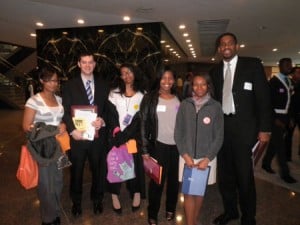FBAR, otherwise known as Foreign Bank Account Reporting Form TD 90.22-1, is a separate filing from the U.S. Income tax return. Its purpose is to inform the federal government of the existence of foreign financial accounts in which you have an interest. Why do they want to know about this? To protect against international terrorism, combat money laundering and other crimes and to identify illicit funds or income escaping federal income tax because the money is being hidden outside the US!
Who is required to file?
Posts By: Zinner & Co.
What the FBAR are you talking about?!?!?!
Zinner & Co. international , Taxes - Planning, Rules and ReturnsPosted by: Colleen Kaminsky
Last night was one of the most excited and nervous I have felt in a long time! As a CPA, I am used to stressful deadlines, but I rarely fear the threat of personal injury. A paper cut is at the top of my danger list, and it can seriously ruin my day. But, staring through the glass wall into the beautiful commercial-grade kitchen at Cleveland's next hot spot, Pura Vida located in downtown's historic May Co. building, I realized that I would soon be surrounded by flames and sharp knives as I competed with my teammates against some of Cleveland's finest lawyers and professionals. I was a little intimidated to say the least.
Revised instructions to ICE Form I-9 for new employees includes guidance on the E-Verify procedure. E-Verify provides an automated link to federal databases to help employers confirm the employment authorization of new hires. E-Verify is free to employers and is available in all 50 states.
Even though a one-member limited liability company (LLC) is treated as a “disregarded entity” for income-tax purposes, under state law the LLC is still a separate property owner.
The much awaited repeal of the 1099 reporting rules has finally come true.
The Senate approved the retroactive repeal of the expanded 1099 reporting requirements and the legislation was signed by President Obama. The signing of this legislation is sure to put a
smile on the faces of CPAs and business owners everywhere.
IRS Releases 2010 Gift Tax Form...Finally!
Zinner & Co. Taxes - Planning, Rules and Returns , Estates, Gifts & TrustsDue to the late changes in the Federal Gift and Estate Tax law included in the 2010 Tax Relief Act passed on December 17, 2010, IRS Form 709 underwent significant revisions to incorporate those changes.
The credit covers textbooks and other course material expenses —as well as tuition and fees not covered by scholarships or grants up to $2,500 each year for the first four years of college. Forty percent of the credit is refundable.
The NACS has created a Web site, www.textbookaid.org, to provide information about how to best take advantage of the program, according to NACS director of government relations Rich Hershman.
The association has also developed brochures and a Facebook page in partnership with the Internal Revenue Service. It includes a summary of the AOTC, explanatory examples, answers to frequently asked questions about the credit, and direct links for further information from the IRS.
For more information, contact Howard J. Kass, CPA, Partner, at hkass@zinnerco.com.
So What's this Thing Called a Generation Skipping Tax Exemption?
Zinner & Co. Estates, Gifts & TrustsWith the recent increase in the lifetime generation skipping tax exemption to $5 million, effective for 2011 and 2012, you may be thinking that there is no way that this could apply to you (or your spouse). While this may only affect a smaller portion of taxpayers than before for those with potential exposure, let me explain how this works, as simplistically as possible.
About Us

Since 1938, Zinner has counseled individuals and businesses from start-up to succession. At Zinner, we strive to ensure we understand your business and recognize threats that could impact your financial situation.
Recent Blog Posts
Categories
- 1031 Exchange (2)
- 401k (2)
- 529 plan (4)
- ABLE Act (1)
- account systems (3)
- accounting (8)
- Affordable Care Act (8)
- alimony (2)
- American Rescue Plan Act (1)
- Ask the Expert (5)
- Audit and Assurance Department (13)
- audits (8)
- Bank Secrecy Act (1)
- banks (1)
- Barbara Theofilos (6)
- Beneficial Ownership Information (1)
- Bitcoin (1)
- block chain (2)
- BOI (3)
- Bookkeeping (1)
- Brett W. Neate (28)
- budgets (1)
- Bureau of Worker's Compensation (12)
- Business - Management, Issues & Concerns (50)
- business income deduction (3)
- business succession (7)
- business travel expense (3)
- business valuation (5)
- capital gains (2)
- careers (7)
- cash flow (2)
- Child Tax Credit (2)
- Chris Valponi (8)
- City of Cleveland (1)
- Cleveland COVID-19 Rapid Response Fund (1)
- Cleveland Rape Crisis Center (2)
- college (3)
- Community (24)
- Compliance (1)
- Coronavirus (24)
- Corporate Transparency Act (1)
- COVID-19 (30)
- Credit card fraud (5)
- credit reporting (2)
- cryptocurrency (2)
- CTA (2)
- cybersecurity (16)
- dead (1)
- DeAnna Alger (6)
- death (2)
- debt (4)
- deductions (14)
- Deferring Tax Payments (4)
- Department of Job and Family Services (2)
- depreciation (1)
- Digital Tax Payment (1)
- divorce (4)
- DOMA (3)
- Economic Impact Payments (2)
- Economic Injury Disaster Loan (4)
- education (8)
- EIDL (1)
- electronic filing (4)
- Electronic Tax Payments (2)
- Emergency Working Capital Program (1)
- employee benefit plan auditor (1)
- Employee Leave (2)
- Employee or Independent Contractor (6)
- Employee Retention Credit (3)
- employment (2)
- ERC (3)
- Eric James (8)
- Estates, Gifts & Trusts (48)
- expenses (5)
- Families First Coronavirus Response Act (2)
- FASB (1)
- FBAR (1)
- FDIC coverage (1)
- Federal Assistance (4)
- filing (3)
- financial planning (8)
- Financial Planning - College (9)
- financing (3)
- Firm news (119)
- first responders (1)
- FMLA (1)
- foreign assets (3)
- fraud (38)
- FSA (1)
- fundraising (9)
- Gabe Adler (1)
- gift tax (5)
- HDHP (2)
- health care (3)
- home (2)
- home office (1)
- Howard Kass (2)
- HRA (1)
- HSA (5)
- identity theft (32)
- income (1)
- income tax (57)
- independent contractor (1)
- Inflation (1)
- Insurance (7)
- internal control (4)
- international (2)
- Intuit (1)
- investments (4)
- IRS (88)
- jobs (5)
- John Husted (1)
- K-1 (1)
- Laura Haines (3)
- Layoff (2)
- Layoffs (1)
- leadership (3)
- lease accounting standards (1)
- life insurance (1)
- LLC (3)
- Loans (2)
- longevity income annuities (1)
- Lorenzo's Dog Training (1)
- Magic of Lights (1)
- management advisory (3)
- manufacturing (2)
- Matt Szydlowski (3)
- medical (7)
- Medicare (2)
- mergers and acquisitions (1)
- Mike DeWine (2)
- Millennial Concepts (2)
- minimum wage (1)
- NAIOP (1)
- National Defense Act (1)
- non-profit reporting (10)
- non-profits (38)
- not-for-profit (26)
- ODJFS (1)
- office (1)
- ohio (13)
- Ohio business owners (18)
- Ohio Department of Jobs and Family Services (3)
- Ohio Department of Taxation (3)
- Ohio Incumbent Workforce Training Voucher Program (1)
- Online Tax Payment (3)
- Operations (2)
- OPERS (1)
- owners of foreign entities (1)
- partnerships (5)
- passwords (1)
- Paycheck Protection Program (9)
- payroll (8)
- penalties (3)
- pension (2)
- personal finance (2)
- planning (4)
- ppp (7)
- Productivity (5)
- Qualified Business Income (1)
- quickbooks (10)
- real estate (14)
- record retention (2)
- records (2)
- Reporting (1)
- Republican National Convention (1)
- Retirement Planning & IRAs (53)
- Richard Huszai, CPA (5)
- RITA (1)
- Robin Baum (6)
- RRF (1)
- S Corporation (1)
- SALT (8)
- SBA (8)
- scams (12)
- SECURE 2.0 Act (1)
- security (6)
- SharedWorks (1)
- Shutdown (3)
- Silver Linings (9)
- simplified employee pension (1)
- Small Business (5)
- SMB (12)
- Social Media (1)
- social security (4)
- Speaker Series (2)
- spouse (1)
- start ups (8)
- Stay at Home Order (3)
- Steven Mnuchin (1)
- Sue Krantz (6)
- SVOG (1)
- tangible property (1)
- tax (27)
- tax avoidance (12)
- Tax Credit (7)
- Tax Cuts and Jobs Act of 2017 (31)
- Tax Exempt (1)
- Tax Holiday (1)
- Tax Interns (2)
- tax services (28)
- taxes (45)
- Taxes - Corporate & Business (104)
- Taxes - Individual (117)
- Taxes - Planning, Rules and Returns (188)
- TechCred (1)
- technology (7)
- The CARES Act (6)
- The SOURCE (1)
- tiag (3)
- transaction advisory (2)
- Treasury Department (5)
- tuition (3)
- U.S. Department of the Treasury (1)
- U.S. Small Business Administration (6)
- Unclaimed Funds (1)
- Unemployment Benefits (4)
- withdrawls (2)
- withholding (6)
- Workers Comp Billing Changes (1)
- Zinner & Co. (32)
- Zinner News (30)





